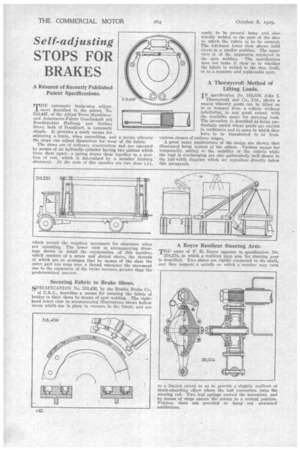Self-adjusting
Page 80

If you've noticed an error in this article please click here to report it so we can fix it.
STOPS FOR BRAKES
A Resume of Recently Published Patent Specifications.
MHE automatic brake-stop adjust ment described in the patent, *No. 318,447, of the Alfred Teves Masehinenund Armaturen-Fabric Gesellschaft mit Besehriinkter Haftung and Nathan Stern, both of Frankfurt, is extremely simple. It provides a ready means for adjusting a brake, when assembling, and a means whereby the stops can adjust themselves for wear of the fabric.
The shoes are of ordinary construction and are operated by means of an hydraulic cylinder having two pistons which force them apart ; a spring draws them together to a position of rest, which is determined by a member forming abutment. At the ends of this member are two slots (A), , which permit the required movement for clearance when not operating. The lower view in accompanying drawings shows in detail the construction of this member, which consists of a screw and slotted sleeve, the threads of which are so arranged that by means of the slots the outer part can snap over a thread whenever the movement due to the expansion of the brake becomes greater than the predetermined amount.
Securing Fabric to Brake Shoes. .
SPECIFICATION No. 318,436, by the Bendix Brake Co., of U.S.A., describes a means for securing the fabric of brakes to their shoes by means of spot. welding. The righthand lower view in accompanying illustrations shows hollow rivets which are in place in recesses in the fabric, and are ready to be pressed home and electrically welded to the part of the shoe to which the fabric is to be secured. The left-hand lower view shows solid rivets in a similar position. The upper view is of the apparatus employed in the spot welding. The specification does not make it clear as to whether the fabric is welded to the shoe itself, or to a separate and replaceable part.
A Thornycroft Method of Lifting Loads.
IN specification No. 318,330, John I. Thornycroft and Co., Ltd., shows a means whereby goods can he lifted on to or lowered from a vehicle without interfering, to any great extent, with the available space for carrying load. The invention is described as being particularly useful where goods are carried in containers and in cases in which they have to he transferred to or from various classes of railway wagon.
A great many applications of the design are shown, that illustrated being typical of the others. Various means for temporarily adding to the stability of the vehicle while the load is overhanging are also particularly well shown in the full-width diagram which we reproduce directly -below this paragraph.
A Royce Resilient Steering Arm.
Tlili name of F. H. Royce appears in specification No. 318,374, in which a resilient drop area for steering gear is described. 'Two plates are rigidly connected to the shaft, and they support a spindle on which a member may turn
o a limited extent so as to provide a slightly resilient or shock-absorbing effect where the ball connection joins the steering rod. Two, leaf springs control the movement, and by means of stops ensure the return to a central position. Friction discs are provided to damp out unwanted oscillations.




























































































































